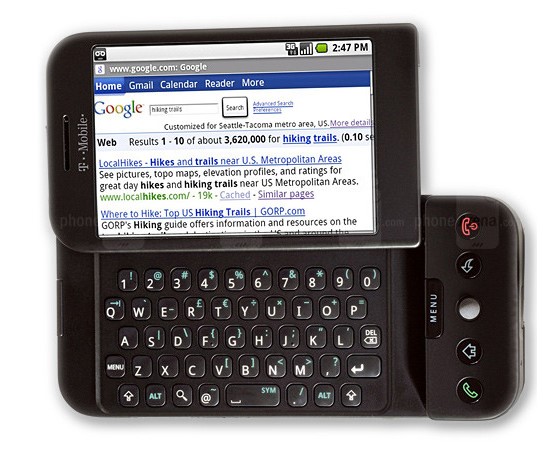
by Larry Magid
This post appeared in the Mercury News on October 16, 2008
Like my Mercury News colleague Troy Wolverton, I agree that the new T-Mobile G1 — the first phone to use Google’s open-source Android operating system — doesn’t quite measure up to the iPhone.
But after using the G1 and several smart-phones with other operating systems, I’m convinced that it will make an impact

not so much because of how good it is but because it might help further slash prices and improve the functionality of other smart-phones.
Smart-phones — including some models of the BlackBerry and phones running Windows Mobile — have dramatically come down in price over the past couple of years. I recently walked by a store that was offering the BlackBerry Curve for $49 with a two-year contract. AT&T sells the full-featured BlackBerry 8700c for that price and you can easily find plenty of other smart-phones for under $80. True, $49 isn’t free, but it wasn’t long ago that you had to pay that or more for a regular entry-level cell phone.
Serious but flawed
Despite some flaws, the G1 is a serious smart-phone with a pull-out QWERTY keyboard and the ability to run lots of third-party applications.
But what’s most interesting about the phone is its open-source operating system. There are already more than 30 companies that have endorsed the platform. That group, which calls itself the Open Handset Alliance, is made up of major phone makers like LG Electronics, Motorola and Samsung as well as HTC, which builds the G1. Carriers from around the world, including China Mobile, Japan’s NTT DoCoMo, Telecom Italia and Sprint, also are members. Germany’s T-Mobile, the first carrier to deploy an Android phone, claims to have more than 112 million mobile customers in Europe and the United States.
While it’s great to see such a coalition of major companies, my guess is that the real growth in cell phones will come from no-name companies in China and other parts of Asia. Just as with Linux phones, these companies can create phones based on Android without having to pay royalties to Google or any other developer.
While a few of these companies will take advantage of the open-source nature of Android to distinguish their phones from others, many will simply ship whatever flavor of Android they can get hold of for free.
That won’t raise the bar in terms of quality but it will lower the price point for those users who want the basic smart features and don’t care about cutting-edge innovation.
Competitive marketplace will challenge Apple
In the meantime, other phone makers and carriers can try to compete based on quality and features, which could result in a robust competitive marketplace that really does challenge Apple by taking advantage of the real power of Android — the ability to modify the source code and add applications that enhance the functionality.
For example, one of my biggest complaints about the T-Mobile G1 is that it doesn’t offer an optional touch-screen QWERTY keyboard. I love the fact that it has a pull-out physical keyboard but there are plenty of times when it might be more convenient to type on the screen.
To enter a Web URL, for instance, you pull out the keyboard and turn the unit on its side to landscape mode, but in many cases it might be a lot easier just to bring up a virtual keyboard on-screen.
Another flaw in the G1 is the relatively weak approach to e-mail (other than Google’s Gmail), including the lack of Microsoft Exchange support and inability to synchronize your PC’s address book and calendar (it does automatically sync with the Web-based Gmail address book and Google calendar but not Outlook). These are serious flaws, but because this is an open-source operating system, anyone with the skills to fix them is free to do so.
And, unlike the iPhone’s application store, which is policed by Apple, Google and its Open Handset Alliance partners say they won’t block applications unless they have security flaws or otherwise violate Google’s terms of service. Google does reserve the right to “remotely remove” applications that violate its terms, but the company has said that it would do this only in the case of malicious software. “In limited cases where an application has a malicious intent, we will remove it from the market and potentially uninstall it from user devices to ensure the safety of the Android Market community.”
This robust open application environment could, over time, encourage thousands of developers to create interesting programs for Android.
Of course, there are already thousands of iPhone applications thanks to Apple’s market success and incredibly energetic developer evangelism. And we are already seeing some of the iPhone apps being ported over to Android.
In the meantime, Microsoft, Research In Motion, Apple and Palm are not likely to sit still. We’re already seeing some creative new phones from RIM, including the BlackBerry Storm and the Bold that are aimed squarely at the consumer market, and a new, more consumer-friendly version of the Palm operating system is said to be in development.
Let a thousand cell phones bloom
I never palled around with Chairman Mao, but I agree with the statement “let a thousand flowers bloom” that was attributed to him (albeit a slight misquote). His cultural revolution is over, but thanks to his country’s manufacturing prowess, I expect to see the blooming of thousands of smart cell phones.